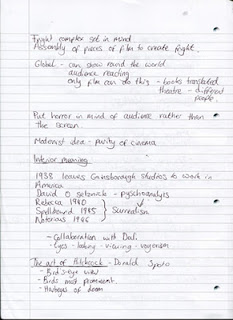For the next few weeks we have 3 lectures on film theory, each looking at a specific area within that. This week the lecture was on The Auteur and was focusing mainly on Alfred Hitchcock. An auteur is normally a director whose movies are characterised by a filmmaker's creative influence. They are similar to artists in the way that they produce original work and have their own creative control. In the 'Auteur Theory' by Sarris (1962), he explained that they should all have a technical competence and that the director's distinguishable personality should be able to come through within the movie. The technical competence of the director in Hitchcock's case was that he was able to tell his story visually in the silent era; he used montage and cutting to create tension within his films; the use of subjective camera - the point of view of the character in the film. All their films should have an interior meaning - a deeper meaning than what is just seen on the surface.
Hitchcock himself is said to be the master of suspense and that he was influential in later genres such as 'slasher' films. In 1920 he started off in the film industry by drawing sets and continued his apprenticeship alongside Graham Cutts at Gainsborough. In 1927 Hitchcock produced 'The Lodger', this was his first acknowledged film, he created clever and creative ways to show things through silent film. For example he shot through a glass ceiling to show visually someone pacing, he had to do this as this was the silent film era. Hitchcock created another film called 'Vertigo' and this was where he used the now famous 'dolly zoom' technique. This is where the camera is placed in certain places to give the viewer the feeling of unnerving. In 'Vertigo' it was placed from high buildings to give the sense of height and portray the characters emotions towards it.
Alfred Hitchcock was also famous for using cutting and montage. In 'Psycho' wanted to put horror in the mind of the audience rather than on the screen, and he had to show it in a way without it showing anything inappropriate for the time. To do this he used cutting and montage. Hitchcock describes cutting as almost severing and montage as the assembly of pieces of film. He creates juxtaposition of the imagery in various sizes to create the shot. It is down to pure cinematics, how the assembly of film in a particular order can instantly be changed to create a new idea and meaning.
As Sarris said, an auteur's film should have an interior meaning, in Hitchcock's case this came into play when he left Gainsborough Studios in 1938 to work in America. There he met David O Selznick who introduced him to psychoanalysis. From this they went on to create Rebecca (1940), Spellbound (1945) and Notorious (1946), all exploring the ways of psychoanalysis. In a way it relates to surrealism and in actual fact, Hitchcock collaborated with Salvador Dali for the dream sequence of 'Spellbound'.
People may say Hitchcock was a brilliant auteur, however there are criticisms of the auteur. Even though the film can be sold to audiences under the director's name, it disguises the work of all others. What about the cinematographer, editor, sound technicians, screen writer and art director? By referring to only the auteur of a specific film you are almost undermining the work of others. They will never be able to get the credit they deserve. Without all the other people behind the scenes Hitchcock and other famous auteur would not be able to produce the film they want. Yes the auteur is in control of the film itself, yet they can never have full control as it is always a group collaboration. Hitchcock mentioned that only film can be shown round the world where nothing has to be changed, people will be able to understand what is going on. It is not like books where it has to be translated and some meaning are lost; or even theatre where there is a different cast and their acting is not the same as the original cast. Is this true though? Can film offer a universal view of quality? Surely there will be some disagreement of views, not everyone will think the same or get the same meaning out of the film. You can achieve a basic and simple meaning however everyone looks at things in different ways.
Through this lecture I have learnt that there are good and bad points to an auteur, they are very creative in the way they convey their ideas however I feel it isn't right that the films they produce are known under their name. More people should get credit for it. Collaboration is key in any for of media where it be film, games or animation. No one person can do it alone, you need to build up good relationships with the people you work with. With this you create a good communication and the overall product will in turn become better. Auteurs are involved in the bigger picture, the art community around them. They visit galleries, read up on books etc. This is quite useful as you are then able to bring different medias together and open it up to a wider audience.








No comments:
Post a Comment